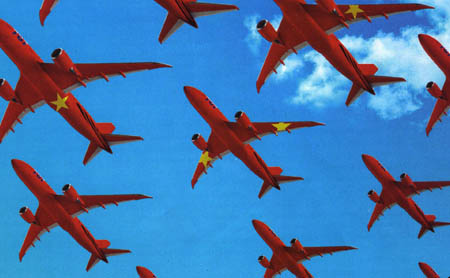China’s Aviation Challenge
By James Fallows | 06.18.12 12:03 PM

From the outside, the only question about China’s nonstop growth is which milestone the country will roar past next. China is already the second-largest economy in the world, after not making the top 10 just a generation ago. According to some growth-rate predictions, it’s now within a generation of overtaking the US and becoming number one. And by many measures, it’s already in first place: New roads built, cars bought, mobile phones in service, Internet users signed on—based on these and other categories, the center of the world’s economic activity has moved to China.
From inside China, things look dicier. The country has plenty of problems: an environmental catastrophe that has made cancer the leading cause of death, tensions that arise in one of the most unequal societies on earth, challenges to the legitimacy of the only major government that does not let its people vote. And while Americans and other outsiders fear that China has devised the economic model of the future, many of the country’s leaders worry that the model has run its course. Even in China there are only so many dams to be built, high-speed railroad lines to be laid, brand-new cities to be populated. China has proven that you can move people en masse from rural poverty to urban factory life in a single generation, by embracing the role of outsourcing workhouse of the world. But Chinese economists fear that this may turn into a low-wage trap that will keep the country from creating the kind of large professional, high-end entrepreneurial, and upper-middle classes that the US has long enjoyed.
Thus the Chinese determination, spelled out in its 12th Five-Year Plan to “move up the value chain.” Can it succeed? Will the next Apples, Facebooks, and Googles arise in China? How much do the current Pfizers, GEs, and Boeings have to fear?
The answer will be found in apex industries, those clusters of businesses whose vitality signals the presence of surrounding networks of high-value skills, technologies, and operational competencies. Wildlife biologists look for healthy populations of amphibians—newts, frogs—to indicate the broader health of a wetland environment. Similarly, economic analysts can look to the status of pharmaceutical industries (which reflect a strong research culture), university complexes (whose ability to draw and hold the world’s talent reflects the attractiveness of a society), and venture capital and info-tech industries (which depend on openness) to judge overall economic vitality. And in China they should be looking at aerospace.
Aerospace has long been an American bulwark. In most years Boeing is the nation’s leading exporter. America has more airports, builds more airplanes, trains more pilots, and arranges more of its economy around aviation than any other country, by far. China would very much like a piece of this—to have Boeings, NASAs, Cessnas, and fully fledged GPS systems of its own. The 12th Five-Year Plan lists aerospace as a symbol and target of China’s “high-value” ambition. Over the next few years, the country will attempt to re-create all of America’s 100-year aerospace history: from the glamor and popularization of flying in the Lindbergh era of the 1920s, through the airport-building boom of the 1940s and 1950s and the moon race in the 1960s, to the routinization (and immiseration) of airline flight now.
OK, the Chinese hope to skip the immiseration. Otherwise they’re trying to do it all, with 100 airports under construction, several airliner models being developed, and a business-jet culture taking hold.
The most ambitious of these efforts, a moon shot, reveals the least about the country’s high-value potential. In a sense, it’s a flying version of the Three Gorges Dam, one more massive public-works effort. The more significant apex-industry test is whether the Chinese system can integrate the complex array of tasks necessary to build safe airplanes and manage safe airlines, at much higher volumes and on tighter schedules than they currently do (like those in the US and Europe). Targets include shared public and private responsibility for safety, shared military and civilian control of airspace, international standards applied in a domestic setting, and the balance between strict by-the-book procedure and individual initiative that keep aerial challenges like the “Miracle on the Hudson” landing from turning into tragedies.
“This industry is the perfect test case of economic maturity,” a longtime Boeing and FAA employee named Joe Tymczyszyn told me in Beijing, where he has moved to help the Chinese develop their aerospace industry. So to truly understand how close China is to realizing its potential, keep your eye on the skies.









